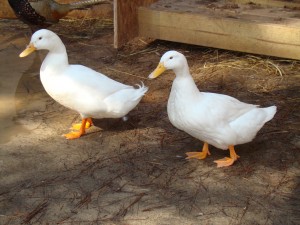The eggs must be turned 2-6 times a day during incubation. This occurs naturely when the female duck changes her position while sitting the eggs. For artificial incubation, mechanical turners are available which will consistantly turn the eggs
Three days before they are due to hatch the eggs should be moved to a hatcher space. This has a slightly lower temperature and higher humidity which increases the hatch % of the ducklings.
Pekin duck eggs are generally easy to hatch as they are very tolerent of slight variations in temperature and humidity.
Pekin can and will brood their own clucthes of eggs.
Pekin ducklings are bright yellow with an orange bill, legs, and feet.
It can be difficult to determine the sex of the young ducklings . Males after a few months can be sexed by the tail curl at the rear feathers.
Females can be sexed usually earlier as they are the only ones that actually (quack).
The Pekin duck is one of the most popular ducks for private ponds. Being they don't fly very well they will stay on your pond for years. The beautiful white majestic look they have while scouring your pond for small insects and minnows makes them the perfect scenery while giving you hours of enjoyment. Feeding them by hand is easily accomplished by regular interaction with them as they are generally a very sociable and friendly breed of duck. Security is a little more of concern with Pekin as they do not fly well so they are a bit more at risk of predation than some other breeds.

